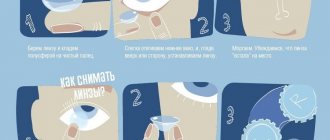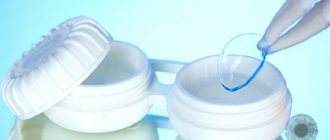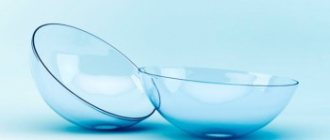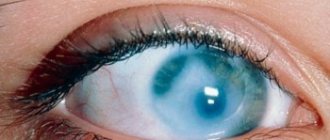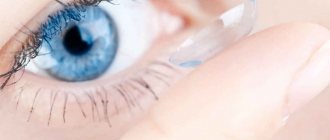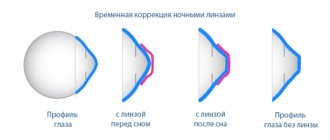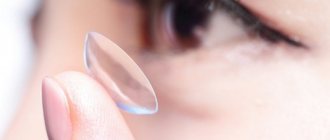Tips for caring for lenses
Proper contact lens care prevents serious eye diseases, some of which can lead to blindness. Such care involves following the following recommendations:
- Remove contact lenses before any contact with water: when taking a bath or shower, when swimming in a pool or swimming in a pond.
- Be sure to wash your hands before removing and putting on your lenses. Hands should be washed with soap and dried with a towel.
- Clean contact lenses as recommended by your eye doctor or lens manufacturer.
- Disinfect your lenses. Regular saline and moisturizing drops are not suitable for disinfection as they do not kill bacteria. Choose special antibacterial agents for disinfection.
- To clean and disinfect lenses, use only a fresh portion of the product.
- Store lenses in a clean, sanitized container.
- Do not use contact lenses for longer than the period specified in the instructions.
- Do not lend your contact lenses or contact lens case to others.
- If the lenses cause noticeable discomfort or even pain, remove them and consult a doctor immediately.
- Visit your ophthalmologist regularly. This will allow you to determine how suitable your lenses are for you, as well as to notice early signs of infection or eye disease.
Modern brands
The most popular are long-wear contact lenses from manufacturers such as Bausch + Lomb, CIBA Vision, Johnson & Johnson and Cooper Vision.
Bausch+Lomb
Bausch + Lomb produces Pure Vision continuous wear silicone hydrogel lenses. They provide high clarity of vision even in poor lighting and in the evening. Thanks to special manufacturing technology, the lenses are comfortable and safe to use. The oxygen transmittance of Pure Vision lenses is one hundred and thirty units.
CIBA Vision
One of CIBA Vision's products is Air Optix Night & Day contact lenses. They can be worn for a whole month, while providing complete comfort to the eyes, since the lenses are not felt on the eyes. Air Optix Night & Day lenses are made from lotrafilcon B, which provides good hydration. And their smooth surface does not accumulate protein and fat deposits.
Read more about daily colored lenses with diopters in the article.
Acuvue Oasys by Johnson–Johnson
Acuvue Oasys lenses from Johnson & Johnson can be used for up to seven days of continuous wear. The oxygen transmittance coefficient of these lenses is one hundred and forty-seven units, which provides one hundred percent comfort.
Cooper Vision
Contact optics manufacturer Cooper Vision offers Biofinity continuous wear lenses. Their manufacturing technology allows you to wear lenses without removing them for up to fourteen days in a row. Biofinity lenses have a high oxygen transmittance (one hundred and sixty units) and moisture content (forty-eight percent).
I According to wearing mode
- lenses are:
- continuous wearing (can be used day and night without removing for up to 30 days). This wearing mode is only suitable for lenses with an oxygen permeability higher than 100 (Dk/L =↑100).
- prolonged wearing (can be used without removal for 7 days/6 nights). With this method of wearing, it is necessary to remove the lenses at night once a week. Lenses must be replaced with new ones weekly.
- flexible wearing (you can sometimes sleep in the lenses, but no more than 3 nights in a row).
- daytime wear (recommended use during the day and mandatory removal at night every evening).
For daily wear contact lenses, materials with both high and low oxygen permeability are used. For extended wear and flexible wear, only high Dk/t contact lenses (high Dk and/or thin design) are recommended. Many silicone hydrogel lenses are approved for extended wear and flexible wear.
What are two-week lenses
Biweekly lenses are soft, routine replacement lenses that can be worn for two weeks. This means that they are put on in the morning and taken off in the evening.
It is important to know how to choose daily contact lenses. However, there are also two-week long-acting lenses that can be left in place at night for up to 6 days.
This type of contact lenses is especially convenient for those who use them every day. Firstly, this option is much less expensive than buying one-day lenses, and secondly, after one-day lenses they have the shortest service life, during which time they do not lose their characteristics and do not have time to accumulate microbes harmful to the eyes.
Two-week lenses are the most comfortable for the eyes:
- They are made of soft, oxygen-permeable material;
- They have a smooth but non-slip surface, which makes them easy to put on and take off;
- They do not have time to accumulate protein that is harmful to vision.
How often should you replace soft contact lenses?
Depending on the period (frequency) of replacement, contact lenses are:
— One-day — Planned replacement — Traditional.
Daily contact lenses are worn only during the day, removed at night and thrown away. Daily disposable contact lenses provide the healthiest and safest contact lens wearing experience. Daily contact lenses require no maintenance. The article “Daily contact lenses – the “healthiest” type of contact lenses” is devoted to daily contact lenses.
Scheduled replacement contact lenses last longer: from 1-2 weeks to 3 months. The most common wearing regimen is replacement after 1 month.
Traditional contact lenses are worn for six months or a year without replacement. This mode of wearing is now practically excluded from world practice (except for hard contact lenses), since during such a long period of wearing various deposits accumulate on the contact lens, wearing comfort and quality of vision deteriorate and the risk of eye infection increases.
Tips for choosing lenses
Each person is individual, and each of us has special vision parameters. Therefore, the ophthalmologist writes a prescription for contact lenses taking into account visual acuity, optical power and radius of curvature, and so on.
In order to choose the right glasses, you need to check your visual acuity, see how to do this at this link.
Let's look at the most popular brands of continuous wear lenses and their features that will help you make your choice:
Bausch&Lomb. The manufacturer states that the lenses are intended for continuous use for one month. However, in reality everything is different: they must be removed at night after eight hours of wearing, otherwise you can get corneal edema. The problem is that Bausch&Lomb lenses are made of hydrogel. This material does not have very good oxygen permeability. According to the manufacturer, Optima FW lenses are very convenient and comfortable. Customer reviews of lenses for continuous wear for up to three months vary greatly. Some people think the lenses are good, while others say they will never wear them again. PureVision 2 HD. These lenses have a one-month replacement period and are made of silicone hydrogel. This material allows oxygen to pass through well, so the eyes “breathe” throughout the entire wearing period. PureVision 2 HD long-wear lenses are also suitable for dry eyes.
Bausch&Lomb
- Ciba Vision. Air Optix Aqua lenses have special UV protection. Therefore, they prevent the development of lens opacities, corneal dystrophy and many other problems. Lenses from the manufacturer Ciba Vision are well moisturized and have a high degree of oxygen permeability.
- CooperVision. This manufacturer produces two types of lenses for long-term wear: Biomedics 55 and Biofinity. Biomedics 55 continuous monthly wear lenses are well-hydrated and have up to ninety-eight percent UV protection. And Biofinity lenses are very comfortable and are not felt on the eyes.
- Johnson&Johnson. Lenses from this manufacturer are considered the most comfortable. The material used is silicone hydrogel. It provides good oxygen permeability. One of Johnson&Johnson's product options is ACUVUE OASYS monthly lenses for two-week continuous wear. They have UV protection and are suitable even for dry eyes.
Johnson&Johnson
Stamps
Acuvue by Johnson & Johnson:
- Two-week silicone hydrogel contact lenses Acuvue Oasys - daily wear, which can be used in an extended mode for up to 6 days;
Air Optix from Alcon–Ciba Vision:
- Monthly silicone hydrogel contact lenses Air Optix Aqua - daily, flexible and extended wear for up to 6 days;
- Monthly contact lenses of extended and flexible wear Air Optix Night&Day Aqua - daytime, flexible and extended wear up to 30 days;
Biofinity from Cooper Vision:
- Biofinity monthly silicone hydrogel contact lenses can be worn during the day or up to 7 days without removal.
Technique of use
As a rule, you can try putting on and removing contact lenses for the first time in your eye doctor's office. The doctor can tell the patient about 2 existing application methods. You can put on the lens using both hands or one of them. The future user independently determines which method will be more convenient for him to perform all the necessary manipulations with it.
Putting on with both hands
Place the lens on the pad of your index finger. Using the middle finger of one hand, pull down the lower eyelid. Using the middle finger of your other hand, pull your upper eyelid upward. After this, apply the lens to the mucous membrane of the eye and, without letting go of the eyelids, move your gaze: the lens will be in the desired position. Then you can release both eyelids.
One-handed putting on
Place the lens on the pad of your index finger. Using the middle finger of one hand, pull down your lower eyelid while looking straight ahead. You can hold the upper eyelid with your other hand to prevent blinking. Turn your gaze upward and, without looking at the lens, apply it to the mucous membrane of the eye. After this, slowly lower your gaze down and release your lower eyelid. Then you can close your eyes and the lens itself will move into the desired position.
Removal
Pull your lower eyelid with your middle finger while looking upward. At the same moment, slide the lens down using your index finger. Using the pads of your index finger and thumb, pick up the lens using a pinching motion and place it in a container with the solution for subsequent storage and disinfection. Do the same with the second lens.
What is better to use - plus contact lenses or glasses for vision?
When deciding whether optical lenses or contact lenses are better, the patient’s wishes alone are not enough. The following details are important:
- Age. It is not recommended for patients under 12 years of age to use the contact method of correction. Elderly people have difficulty fixing products. Therefore, doctors most often recommend glasses to such patients.
- Type of professional activity. If a person works in a chemical plant and a dusty factory, then glasses are better suited. Doctors will help you choose glasses for your vision, and also advise patients who work in the medical and construction fields to use lenses. The contact method is also indicated for professional athletes.
- Health status. If you have problems with coordination of movement, fine motor skills or mental disorders, then wearing contact lenses is prohibited.
- Driving. For people who spend a long time driving, ophthalmologists recommend using soft lenses. Thanks to them, high clarity of vision at night is achieved.
What are daily wear contact lenses?
The mode of wearing contact lenses implies the period of time during which you are allowed to wear the lenses without removing them. In particular, daytime wear is the use of lenses only during the day. These lenses should be removed at night.
It is recommended to wear daily lenses no more than twelve hours a day. After removal, they need to be placed in a container with a disinfectant solution so that by the morning the optics are fresh and clean.
- Day lenses can be hydrogel or silicone hydrogel.
- Hydrogel lenses are very comfortable to wear, they are thin and soft. Such lenses moisturize the eyes well, but have a low percentage of oxygen permeability.
- Silicone hydrogel lenses allow oxygen to pass through well, they are more elastic than hydrogel lenses, so they hold their shape well.
If you choose silicone hydrogel lenses, you should remember that it is important to follow the wearing regimen:
- It is necessary to cleanse every evening.
- After the wearing period has expired, you should throw away the old pair and put on a new one.
Daytime contact lenses vary in terms of wearing time:
- Traditional lenses can be worn from six months to nine months. They are the most affordable, but they will require not only a regular solution, but also an enzyme solution, since these lenses accumulate protein and lipid deposits.
- Quarterly lenses have a wear period of three months.
- Planned replacement lenses can be worn for a month. They are the most popular lenses. You don't need to use an enzyme solution for them.
- Frequently scheduled replacement lenses have a service life of up to two weeks.
- Daily lenses are put on in the morning and removed and discarded at night. They are the safest for the eyes.
About wearing and replacing contact lenses
Compliance with the wearing regimen and replacement regimen is the key to comfortable use of contact lenses and the absence of eye diseases. Wearing mode is how long we wear the lens during the day or how many days we can wear it without removing it. Replacement mode is when we need to change our contact lenses to new ones. There are three types of wearing modes: daily, extended or extended, and continuous. According to the replacement mode, contact lenses are divided into: daily, frequent scheduled replacement, quarterly (scheduled), and traditional (semi-annual and annual).
Frequently scheduled replacement contact lenses need to be replaced with a new pair every 1 - 2 weeks (in the case of quarterly replacement - once every 3 months) and daily care with a special solution. The solution cleanses them of deposits that accumulate on them during the day, and also disinfects them. Acuvue Oasys are of this type and can be worn for two weeks and then need to be removed to put on a fresh pair.
Traditional contact lenses are used from six months to a year. The important rule is thorough cleaning. After 3 weeks they require treatment with enzyme cleaners. An example is Morning 38 and Morning 55 from Interojo.
Daily disposable contact lenses are increasingly becoming the choice of most optical store shoppers. There are several reasons for this. Firstly, they do not require any care procedures; you put them on in the morning and throw them away in the evening. Secondly, a minimal amount of various types of deposits accumulates on them, which has a positive effect on eye health. Thirdly, you can swim in them, after which you must immediately take them off. And fourthly, daily replacement contact lenses are suitable for those with allergies, since a minimal amount of allergens accumulate on them. If you decide to choose daily lenses, then be sure to try 1 Day Acuvue TruEye and 1 Day Acuvue Moist.
According to the mode of wearing lenses, there are: daytime, extended mode and continuous . Accordingly, the daytime mode can only be worn during the day. And the extended mode allows you not to remove the lenses even while sleeping; they are worn for 6 days and 7 nights in a row, for example, this can be done with Acuvue Oasys lenses from Johnson & Johnson. This is convenient for those who have an irregular schedule and cannot always remove their lenses at night. Continuous wearing models can be used for 30 days without removal without harm to eye health. However, prolonged and continuous regimens are not suitable for everyone; consultation with an ophthalmologist is required.
Risks associated with continuous wearing
Ophthalmologists say that using lenses for a long time throughout the entire month without removing them is extremely undesirable. Therefore, they recommend such contact optics only to those who really need it.
This is a very serious complication that leads to a significant decrease in vision and scarring of eye tissue. In sixty percent of cases, microbial keratitis occurs due to failure to comply with the deadlines for replacing contact lenses and improper storage.
Flexible wearing mode as an alternative
Despite the fact that long-wear contact lenses are made from modern and high-quality materials, this mode increases the risk of developing various complications. Many experts agree that the most optimal mode for using such contact lenses is a flexible mode.
Time and modes of wearing contact lenses
Each contact lens manufacturer specifies a strictly defined service life for their product. That is why, before making a purchase, you should definitely clarify this parameter. Your comfort when using contact lenses, and, in some cases, the health of your visual organs depends on it.
The service life of lenses is determined by a number of factors. The key role is played by the material from which they are made, as well as production technology. There are cases when lenses made of the same material have different periods of use. To avoid misunderstandings, all lenses sold in the LansGo.ru store have a clearly marked service life on the packaging.
In addition, the lifespan of lenses may be shortened due to careless handling, exposure to aggressive cosmetics or poor-quality cleaning compounds. It should be understood that the stated service life is not a warranty period, but only indicates the time period after which the lenses must be replaced. It is very important not to neglect the planned replacement of lenses, since over time they lose their properties, and therefore, the clarity of vision can decrease and even damage the health of the eyes.
As for the expiration date indicated on the packaging, it only means the period during which the lenses remain in sterile conditions. Many users, unknowingly, abandon their lenses after this period, believing that they have become unusable. This is a mistake, since their properties can be completely restored after treatment with a special laboratory solution.
According to their service life, all contact lenses are usually qualified for:
- Traditional. As a rule, hydrogel is used in their manufacture, and the service life of the lenses varies in the range of 6-9 months. Despite their low price, these contact lenses have some disadvantages. In particular, they require additional costs for daily care products, as they tend to accumulate various deposits that are favorable for the development of fungal and microbial infections. An important point is that traditional lenses are always sold in special glass containers. If you become the owner of lenses in a blister, then in terms of their service life they do not fall under the definition of traditional!
- Quarterly. Designed for 3-month wear and sold in blisters. Note that these contact lenses have become a transitional link between outdated traditional models and the most popular - planned replacement.
— Planned replacement lenses. Today they are very popular and are designed for monthly replacement. In their manufacture, both traditional materials and innovative silicone hydrogel materials are used. Among the advantages, it is worth noting the absence of the need for complex enzymatic cleaning and convenience for people who require different levels of vision correction for the left and right eyes. In addition, some lenses can be worn without removing them from the eyes throughout their entire service life.
— Frequent scheduled replacement. These lenses are made from modern materials with a high moisture content. Their service life is no more than 1-2 weeks, and they do not require complex cleaning procedures.
- Daily replacement. With these lenses, you no longer need to worry about possible eye inflammation and discomfort when wearing them. They are designed for 1 day of wear, so you always use sterile lenses. This feature provides crystal clear vision, but at the same time requires large financial costs from the patient.
As practice shows, the vast majority of people with vision problems give their preference to contact lenses for daily and routine replacement. Note that they have their own wearing mode:
— Daytime – lenses are marked DW, designed to be worn during the day and removed at night.
— Flexible – they are marked FW, allowing periodic wearing during sleep.
- Extended - allows operation for 7 days in a row.
- With continuous wearing for a month.
These simple recommendations are common to all patients. However, it should be understood that each person’s body perceives the same lenses in its own way. And, in order to protect yourself from troubles, you should definitely consult with a good ophthalmologist before using it.
By wearing period
Disposable
Disposable or daily lenses can be worn up to fourteen hours a day. After which the used pair is thrown away and a new one is used the next day.
Advantages:
- There is no risk of developing allergies.
- Safety for eye health.
- Comfort and clarity of vision.
- No need to buy solutions or containers.
- Ease of use.
The most common brand of manufacturer
Disposable lenses are suitable for vision correction and can be used as a replacement for conventional lenses. They are also used after instilling eye drops that dilate the pupils.
Reusable
Reusable lenses are lenses that are used throughout the day and removed before bed. The replacement period for such lenses is once every two weeks.
At night, reusable lenses should be stored in a container with a special solution.
Traditional (from a week to a year)
- The period of use is from six to nine months.
- The material used to make them is hydrogel.
- It is necessary to thoroughly clean the lenses with a disinfectant solution.
Modern manufacturers
- Baush & Lomb. This is one of the largest modern manufacturers of lenses and care products. The most famous and popular lenses from this manufacturer are PureVision silicone hydrogel lenses and Optima and SofLens hydrogel lenses.
- CIBA Vision. The manufacturer CIBA Vision is recognized as one of the leaders in the production of contact optics and additional care and disinfection products. Their lenses are very varied and are made from hydrogel and silicone hydrogel.
- CooperVision. This manufacturer ranks second in lens production. CooperVision is a world leader in toric lenses. Their range is very diverse; many types of lenses can be purchased in Russia.
- Johnson & Johnson Vision Care. This manufacturer is a leader in the production of soft contact lenses. Their most famous product is Acuvue lenses. This family of lenses includes hydrogel and silicone hydrogel lenses.
Modes of wearing contact lenses: what are they and for whom are they suitable?
Nowadays you hardly see people wearing glasses on the streets. And not because there are fewer problems with vision, rather the opposite. It’s just that they are increasingly being solved with the help of contact lenses. However, even those who have been using them for many years often do not know that there are new products that are even more convenient and safer to use.
Traditional lenses, worn exclusively during the day from six months to a year, are gradually becoming a thing of the past. And when the time comes to change your contact lenses, the online store will be able to offer you several new options - consider them. These can be extended-wear lenses, planned replacement lenses, or daily lenses.
You can also consider changing your eye color, even if you don't have perfect vision. Now many manufacturers offer colored and tinted lenses with a wide diopter range. These, for example, include Soflens contact lenses; in color they come not only with zero diopters, but also for vision correction. Moreover, their coloring is not monochromatic, but imitates a real iris - with a darker edge and natural color transitions.
So, what are the different modes of wearing lenses? And which one is better to stop at? Let's look at all the options, with their pros and cons.
Traditional
The lenses last for six months to a year, you only need to wear them during the day, sometimes you are allowed to sleep in them.
Advantages:
· The cheapest way, if you calculate the price per day of wearing
Flaws:
· Requires solution, sterile conditions for removal and donning
· Additional enzyme cleaning is needed (and rinsing with the solution as thoroughly as possible after it, otherwise the eyes sting terribly)
Complications such as microbial keratitis (inflammation of the cornea) are more common compared to other replacement regimens.
Suitable for: Almost everyone, but this wearing regimen is gradually being phased out due to a higher risk of complications.
Planned replacement
The lenses last from two weeks to three months, then they are changed.
Advantages:
· Enzymatic cleaning is not required, a solution that removes protein deposits is sufficient - the surface does not have time to become heavily soiled in a short time
More oxygen reaches the cornea
Flaws:
· You need to remove and put on lenses daily (although a flexible schedule is allowed - sleep in them one or two nights if necessary)
Who is it suitable for: the optimal choice for the majority of people who need vision correction.
Extended Wear
The lenses are put on and worn without removing for a week to 30 days. Only lenses made of silicone hydrogel material are suitable for this mode, since it does not delay the penetration of oxygen to the cornea.
Advantages:
·You always see well
· No need to buy solutions
No need to take off and put on lenses every day
Flaws:
· Requires great caution - since deposits are not removed from the surface, there is a risk of reducing the oxygen permeability of the lens, the manifestation of inflammatory diseases (but it does not exceed those of conventional lenses)
Suitable for: those who find putting on and taking off lenses uncomfortable; whose work involves constant travel (truck drivers, for example); during vacation.
Daily lenses
The lenses are put on in the morning, removed in the evening and thrown away, the next day a new pair.
Advantages:
· No solutions needed
· The greatest sterility is achieved, which means the risk of inflammation is minimized
· Since the lenses do not have time to become dirty, my eyes feel very comfortable
· Suitable even for very sensitive eyes
Flaws:
· Changing lenses every day is expensive, although manufacturers are trying their best to reduce their cost
Suitable for: those who have sufficient financial resources to take the best care of their vision; for whom other methods of contact correction are impossible due to the high sensitivity of the eyes; colored daily lenses – for those who only occasionally want to change their eye color.
Now contact vision correction has reached such a level that many have even stopped thinking about laser restoration surgery - the use of lenses does not entail any restrictions on loads, the list of contraindications has noticeably decreased, and there are more options for wearing modes, which means it has become easier to choose the optimal one. The decision about which one is right for you should definitely be made together with your eye doctor. And remember, no matter which option for wearing contact lenses you choose, you need to monitor the condition of the cornea - for this we recommend visiting an ophthalmologist’s office 2 times a year.
Kinds
Contact lenses, depending on various parameters, are divided into the following types:
- Depending on the material: hydrogel and hydrogel-silicone, polymer lenses.
- Depending on the frequency of replacement: one-day, one-two weeks, 3 months, 6 months, annual.
- Depending on the mode and time of wear: daytime, prolonged, flexible, continuous.
- Depending on the level of transparency: transparent, colored.
- Depending on the type of design: multifocal and spherical.
Ophthalmologists do not divide lenses into small groups and distinguish two main types based on the type of material:
- Soft lenses;
- Hard lenses.
More than 90% of ophthalmologists' patients wear soft lenses, because they are an excellent means of vision correction and have virtually no contraindications for use. This type of lenses is made on a hydrogel and silicone hydrogel base, which is why they must be stored in a special container with a solution.
As for hard lenses, they have a number of advantages over soft ones:
- Retains its shape for a long time;
- They wear for a long time;
- Significantly increase visual acuity;
- Provide a tight fit to the cornea of the eye.
They are ideal for vision correction in the presence of diseases such as astigmatism, orthokeratology, keratoconus. These lenses are made from polymer materials that provide a high degree of oxygen penetration to the cornea.
Proper lens storage
Soft contact lens design
Most commercially available contact lenses are spherical in design and are designed to correct myopia and hypermetropia. The surface of the optical zone of such contact lenses has a shape close to spherical.
Toric contact lenses are used to correct astigmatism . The surface of the optical zone of toric contact lenses is sphero-cylindrical, i.e. the optical power of a contact lens in two mutually perpendicular directions is different (in accordance with the astigmatism of the eye). It is also believed that mild astigmatism (up to 1 diopter) can be corrected with conventional spherical contact lenses . Read more about this type of contact lens in the article “Toric Contact Lenses for Correcting Astigmatism.”
Multifocal contact lenses are available to correct presbyopia . Read more about correcting presbyopia with contact lenses in the article “Contact lenses for correcting presbyopia.”
Some manufacturers also offer aspherical design contact lenses . These contact lenses are also designed to correct myopia, hypermetropia and astigmatism, but the front surface of these contact lenses uses an aspherical design rather than a spherical one. Aspheric design is used in contact lenses to eliminate spherical aberrations of the contact lens, resulting in higher quality vision compared to conventional spherical contact lenses. Currently, there are several aspherical contact lenses, which not only minimize the spherical aberrations of the lenses themselves, but which are also designed to correct the spherical aberrations of the eye (about spherical aberrations, read the article “Spherical aberrations and the wavefront”). These aspherical contact lenses provide even better vision than spherical contact lenses, especially in low light conditions (such as at night).
Hydrogel and silicone hydrogel contact lenses are available in all of these designs on the market.
A separate group of soft contact lenses consists of colored contact lenses . Depending on the intensity of the coloring, they can be tinted (serve to enhance the natural color of the eyes) and radically change the color of the eyes. Some manufacturers also produce decorative contact lenses with various designs (dollar sign, cat's eye, etc.). Read more about this group of contact lenses in the article “Colored Contact Lenses”.
Features of the selection of lenses with diopters
An experienced doctor should help you choose lenses. He will be able to give recommendations regarding the type and mode of such devices. If you purchase it yourself, it is a waste of money, and sometimes the cause of the development of adverse events. This article will tell you about women's glasses.
When choosing products, the following diagnostic procedures are of particular importance:
- visometry – determination of visual acuity;
- refractometry - determination of the refraction of the eye;
- ophthalmoscopy – examination of the fundus of the eye;
- accommodation - study of the reserve of accommodation;
- diagnostics of lateral vision and the ability to simultaneously see a picture clearly with both eyes.
For age-related hypermetropia
It is also worth knowing that multifocal lenses are one of the most effective means of correction for people suffering from age-related farsightedness. There are basic criteria for the correct selection of optical products:
- Optical power. It is responsible for the degree of farsightedness in a particular person.
- Radius of curvature. Each person has a different structure of the eyeballs, but choose a product with a standard radius of 8.6 mm.
- Water concentration. The higher this indicator, the more practical the lenses will be. If you choose more rigid devices, they guarantee picture clarity
- Oxygen permeability. The risk of developing negative phenomena depends on this indicator.
- Tensile strength. The duration of wear depends on this parameter.
Reasons for wearing lenses
Lenses are the preferred optics option, recommended by the vast majority of doctors to their patients. Indications for wearing such products are:
- Farsightedness and myopia, including high degrees;
- Astigmatism (in this case, special toric lenses are used);
- Intolerance to spectacle vision correction;
- A significant difference between the diopters of the left and right eyes, for which the selection of glasses is extremely difficult;
- Vision correction for “lazy eye” syndrome.
Also, lenses are often worn if there are cosmetic problems, including color defects in the iris. Tinted samples of soft optics can also be used to give the eyes a more interesting shade (especially for light-colored irises). Less commonly, lenses are worn without any indication. However, in most cases, tinted models, as well as crazy lenses, are chosen for this.
It is these restrictions that you should first pay attention to when choosing certain product models.
Flexible contact lenses
Selecting the type of contact lenses and going through the adaptation period is necessary only under the supervision of a specialist. This is due to the fact that every person’s body has its own individual characteristics, and each person can react differently to wearing lenses. An ophthalmologist will help you choose lenses that are optimal in terms of their optical performance, as well as determine the appropriate wearing regimen. In some situations, a flexible wearing mode may be recommended for the patient. With this mode, lenses are used mainly in daytime mode (that is, while awake). But occasionally you can ignore them even at night.
This wearing mode will be convenient for those whose work involves traveling or other situations where removing and putting on lenses is not very convenient. In some cases, the patient cannot exactly adhere to the time indicated for daily wear (10-12 hours) and the lenses are in the eyes for 15-18 hours. These situations also apply to flexible wearing mode. There are no separate types of lenses that are intended only for this wearing mode. In flexible mode, you can use some types of lenses designed for daytime and continuous wear. In this case, the packaging must indicate information about the possibility of using this type of lens in a flexible mode.
High-factor silicone hydrogel contact lenses are suitable for flexible wearing
oxygen transmission. These can be either some continuous wear models or those designed for daytime use. Doctors consider flexible wearing mode one of the most physiological. It minimizes the risk of microbial inflammatory processes and, at the same time, makes it possible, if necessary, to leave the lenses in the eyes for quite a long time.
Hygiene procedures for flexible wearing are no different from caring for daily lenses.
After the lenses are removed from the eye, they need to be placed in a container with saline solution. Lenses should not be worn if you have a cold or if you are using certain medications. Also, daytime and flexible wear lenses cannot be used without protective glasses when swimming in pools or open water. Various complications can arise with any mode of lens use, including flexible ones. If you experience discomfort (decreased visual acuity, redness of the eyes, etc.), you should consult a doctor. all articles
Selecting lenses for long-term wear
Currently, the industry offers potential buyers a huge number of lenses with different wearing requirements. And in each category there are more and less acceptable samples for the vast majority of patients. They will be discussed below.
For continuous
This is the thinnest version of optics, which usually does not cause discomfort in use, provides normal air exchange to the cornea, and therefore generally reduces the risks associated with constantly wearing optics. Among the most popular and sought-after manufacturers of this type of product, experts note the following companies and their lines:
- Pure Vision (Bausch + Lomb), as well as Night & Day (CIBA Vision) - are indicated for continuous wear for 30 days.
- Biofinity by Cooper Visio - maximum use period - 2 weeks.
- Acuvue Oasys long-term wear contact lenses from Johnson & Johnson Vision Care are indicated for continuous wear for a week.
- PremiO from Menicon - the wearing period is also no more than 7 days.
All of the above optics allow you to correct the vast majority of visual impairments with maximum comfort for the patient and constitute the best alternative to glasses. And since the best material processing technologies were used during their development, they cause virtually no discomfort when worn.
Only after you have been examined by your doctor and are sure that similar models are indicated for you, can you order them.
Of course, for representatives of many professions and people leading an active lifestyle, such models are much more convenient. However, given the level of health risks associated with them, it is worth considering a safer option for yourself - lenses for daily wear.
For daytime and flexible
This type of optics is preferable for people with highly sensitive eyes, prone to allergic reactions, as well as those who cannot strictly comply with all optical hygiene regulations.
Among daily wear lenses, there are also favorites that have received high marks from ophthalmologists around the world. These include:
- OKVision Premium SiH-48;
- Maxima Optics (UK) Si Hy Plus monthly replacement samples;
- Avaira from Cooper Vision.
They are also suitable for daytime use.
Of course, both continuous wear samples and models for daytime use require careful selection and compliance with all requirements for their use. In this regard, each patient should receive a detailed consultation with the attending physician.
Wearing mode and period of wearing contact lenses
Many contact lens wearers do not understand at all what “wearing mode” and “wearing period” are. These concepts are important and worth understanding so that contact lenses are selected correctly and do not cause discomfort and eye disease.
Contact lens wearing regimen
means the maximum period of time that lenses can be worn without removal.
According to the mode of wearing lenses, there are:
· DW – day mode (must be removed at night);
· FW – flexible mode (lenses can sometimes be left on for 1-2 nights);
· EW – prolonged (can be used continuously for up to 7 days, depending on the manufacturer’s recommendations);
· CW – long-term continuous (without taking off for up to 30 days).
Wearing period of contact lenses
means the maximum period of use of lenses, after which they must be replaced with new ones.
By wearing period:
· daily replacement (one-day, disposable);
· frequent scheduled replacement (every 1 – 2 weeks);
· planned replacement (after 1 – 3 months);
· traditional (after 6 months or more).
When purchasing contact lenses, pay attention to the wearing instructions and always remove contact lenses on time. When wearing lenses, their oxygen permeability, moisture content and other characteristics are of great importance. If the lenses are left on the eyes for longer than expected and if you sleep in the lenses unless permitted by the manufacturer, great harm can be caused to the eyes.
Carefully monitor the period of wearing contact lenses and always replace them with new ones on time. When calculating the replacement period for lenses, the manufacturer takes into account the resistance of their material to protein deposits and dirt. If you use lenses longer than the specified period, this can lead to diseases and inflammation of the eyes.
If you monitor the expiration date, mode and period of wearing contact lenses and always follow the rules for their use, then you will be ensured not only clear vision, but also eye comfort and safety for their health.
Selecting lenses for long-term wear
Silicone hydrogel lenses are today considered the safest among all types of extended-wear contact optics. They meet most of the requirements for continuous wear lenses.
Extended wearing mode
In the table we will look at examples of brands and manufacturers of lenses of this type offered on the market today.
| Stamps | Manufacturers | Advantages |
| Pure Vision Night & Day | Bausch + Lomb CIBA Vision | The lenses have been on the market for 12 years and are FDA approved. They can be worn for up to 30 days in a row without taking them off. |
| PureVision 2 HD | Bausch+Lomb | High Definition optics provide these lenses with excellent vision quality even in dim lighting. They are comfortable and quite safe. Thanks to Comfort Moist technology, these lenses are thinner than previous ones and have a slightly rounded shape. Suitable for both daytime and continuous wear for up to 30 days in a row. Dk/t – 130 units. Packed in blisters with solution. |
| Air Optix Night & Day | CIBA Vision | Updated version of Night & Day with wearing mode up to 30 days. |
| Air Optix Aqua | CIBA Vision | The lenses are made using unique Aqua Moisture technology. They use a triple moisturizing system: a new lubricating agent ensures comfortable wearing, a new material, lotrafilcon B, provides a high level of moisturizing, a smooth polished surface prevents the accumulation of deposits. Continuous wearing mode – up to 6 days in a row. |
| Acuvue Oasis | Johnson & Johnson Vision Care | Used for continuous wear for 7 days. In the manufacture of these lenses, the revolutionary Hydraclear Plus technology is used, which makes it possible to work comfortably at the computer. The oxygen transmission rate is 147 units |
| Biofinity | Cooper Vision | The material of these lenses includes silicone, consisting of long molecular chains (macromers), which requires less than regular silicone for effective oxygen transmission. Thanks to this, Biofinity lenses, along with high Dk/t (160 units), are characterized by a low elastic modulus (0.75 MPa) and high moisture content (48%). The maximum period of continuous wearing is 2 weeks. |
| PremiO | Menicon | These lenses perfectly balance such important parameters as Dk/t (161 units) and moisture content (40%). This became possible thanks to the presence of the hydrophilic MeniSilk monomer and the use of unique Nanogloss surface treatment technology. PremiO contact lenses are resistant to dehydration, which prevents symptoms of dry eyes even when worn continuously for one week. |
Daytime and flexible wearing mode
All lenses presented above are suitable for both continuous, daytime and flexible wearing modes. The modern pace of life dictates to lens users their wearing regime, forcing them to keep their lenses on for 16-18 hours a day.
That is why manufacturers have developed contact optics with a daily and flexible wearing schedule. Such silicone hydrogel samples include the lenses shown in the following table:
| Avaira | Cooper Vision | These lenses are made using Aquaform technology and contain a small amount of silicone, including Enfilcon A material. The elastic modulus is 0.5 MPa. Dk/t – 125 units, and moisture content – 46%. |
| Si Hy Plus | Maxima Optics (UK) | The oxygen transmission rate in these lenses is quite high - 138 units, and the moisture content is 33%. The aspherical design of the front and rear surfaces ensures clear vision even in low visibility conditions. In the production of Si Hy Plus lenses, a patented plasma surface treatment technology is used, which achieves both a high degree of smoothness and resistance to deposit accumulation. Wearing period is 1 month. |
| OKVision Premium SiH-48 | "Okay Vision" | Dk/t -148 units, moisture content - 55%. The lens material not only allows the cornea to receive sufficient oxygen, but also provides users with a high level of comfort. The new aspherical lens design corrects not only aberrations caused by the lens, but also aberrations of the eye itself, resulting in high visual acuity even in twilight. Due to these properties, these lenses are ideal, for example, for drivers. |
Extended or continuous wear lenses
The extended wearing mode allows continuous use of optical products for up to 7 days. This is convenient for travelers, as well as people with an active lifestyle. There are situations when it is not possible to care for contact correction products, for example, the solution runs out on the road or there is no container at hand. Contact lenses with an extended wear period eliminate the occurrence of such force majeure, since they do not require daily cleaning. They can be left on for a week. However, before doing this, it is imperative to consult with an ophthalmologist and assess the possible risks. People with high sensitivity of the cornea, as well as a tendency to allergies or dry keratitis, may experience discomfort when wearing these optical products, especially in the absence of daily care.
Models with continuous wearing mode can be used for up to 30 days (after consultation with a doctor).
Popular models of this type:
- Acuvue Oasys with Hydraclear Plus. Two-week lenses with a high level of oxygen permeability 147 (Dk/t). They have an optimal moisture content (38%) and ensure comfortable operation. Can be used in flexible, daytime or extended mode.
- Air Optix Aqua. Optical products for 1 month, which transmit 4-5 times more oxygen to the cornea than other soft models. Resistant to the appearance of protein and lipid deposits. They have several wearing modes: daytime, flexible and extended.
- Air Optix Night & Day Aqua. A revolutionary model with a record oxygen permeability of 170 (Dk/t). It can be worn continuously for a month. These products are popular among travelers and people with an active lifestyle.
How to use lenses
In the case of two-week daily wear lenses, remember that they must be removed at night. This way, your eyes will rest, and the lenses will be saturated with liquid and cleaned of dirt.
Lenses should only be put on with clean hands, and they should also be removed after washing your hands. If you are new to using lenses, a special lens remover will help you remove them. Not many people know how long they can wear lenses. It should be remembered that the time for using lenses begins to count down immediately after you open the blister with them. We must not forget about proper care of two-week lenses.
When putting on lenses, do not press them to the eye, just carefully place them directly on the cornea, center them and they will stick themselves and take the correct position
If you feel discomfort after putting them on, you need to pay attention to whether the lens is located in the center; if not, then it needs to be centered
It is worth remembering that lenses should be removed at night, unless they are extended-wear lenses, and should be kept in solution at all times.
Two-week lenses are worn for 14 days, after which they lose their performance properties, but do not cause irreparable damage to vision. Such lenses are the golden mean between daily and monthly lenses and have a number of advantages: they are much cheaper, and dangerous amounts of bacteria and infections do not accumulate on them.
Extended wear contact lenses
The advent of contact lenses has become a real salvation for many people with visual impairments, for example, for those who lead an active lifestyle or simply feel embarrassed about wearing glasses. Traditional lenses have one significant drawback - they must be removed at night. In some situations, this is quite problematic to do (in particular, during a tourist trip). And many people simply don’t want to waste time on the daily procedure of taking them off and putting them on. One of the alternative options that eliminates these inconveniences is extended-wear lenses.
This variety is designed for continuous wear (day and night) for one to two weeks. Modern lenses designed for extended wear have high oxygen permeability and good moisturizing properties. But in certain situations, complications may arise when wearing them. Therefore, patients who have never worn contact lenses are advised to switch to the extended-release mode gradually. For a week, the lenses are worn in daytime mode (that is, removed at night). If no complications arise during this time, then they are left for one night. After this, the patient must be examined by a doctor. If the ophthalmologist does not find any problems or abnormalities, you can completely switch to the prolonged regimen.
Extended wear lenses do not require special care. A pair of new lenses are removed from the blister, placed in the eyes, and after the allotted period has expired, they are simply thrown away and a new pair is taken. If mechanical particles (dust, sand, etc.) get into the eye, the lens must be removed and washed with saline or disinfectant solution. Extended wear lines can also be used for daytime use (remove at night). In this case, you need to care for them like regular day lenses - place them in a container with saline solution at night.
In terms of annual costs, extended-release lenses will cost slightly more than traditional ones.
But cost is, to a certain extent, a relative concept. It largely depends on the country of origin, the material from which the lenses are made and some other factors. Therefore, when choosing contact lenses, you should proceed not from financial costs, but, first of all, from medical indications. Prolonged wearing reduces the risk of eye infection (compared to daytime wear). Indeed, in this case, a person touches the lenses with his hands only twice a week - when he puts them in his eyes and when he removes them at the end of the period of use. all articles
Risks associated with continuous wearing
Why is this happening? The fact is that when wearing a lens constantly, the level of moisture in the eye noticeably decreases, which means that the mucous membrane actually becomes more susceptible to microbes. In this condition, a person is more easily infected with conjunctivitis pathogens and is more prone to allergic reactions.
In addition, it is when lenses are worn for a long time that protein residues accumulate on the eye.
Conjunctivitis is the most common of these ailments, but ophthalmologists consider it the lesser of the evils. Doctors call microbial keratitis a much more dangerous phenomenon. What kind of disease is this, and why the risks associated with it are so great, let’s try to figure it out.
Tinted lenses
Microbial keratitis
Keratitis is an inflammation of the cornea, which is accompanied by clouding, as well as pain and redness of the eye. The microbial form of this disease can be caused by amoebic infections. It is this type of disease that can lead to various complications, including the appearance of a cataract, as well as decreased vision and blindness.
It was practically excluded among those who preferred daily lenses from many companies, and was very often observed among people who preferred hydrogel lenses, especially those manufactured in the UK and the Netherlands. You can familiarize yourself with the pattern of occurrence of this disease among regular customers of certain manufacturers in the table below.
Of course, it is almost impossible to completely avoid the risk of this disease. However, it can be minimized. In order to avoid this disease, before you start wearing lenses, you must find out whether you have any contraindications to this optics, and also strictly follow the wearing regimen of the products selected for you and be sure to replace the lenses if they are damaged, as well as the end of the recommended wearing period .
A flexible wearing mode at the modern pace of life is very convenient, because using lenses 10 hours a day is not always enough. With flexible mode, contact lenses can be left on for several days in a row. Therefore, you can not only take a nap for a few hours in them, but also sleep for one or two nights.
If during daytime wear the lens material may not have high oxygen permeability, then during prolonged wear the coefficient Dk will be the highest.
Colored lenses can also have a flexible wearing mode, but they are still not intended for sleep. Yes, you can wear them longer without taking them off, your eyes will be fresh, but even if you take a nap in color contact optics for several hours, your eyes will experience great discomfort, and it will be difficult for the user to use them in the future. If this happens, then it is impossible to avoid dry eyes; the situation can be corrected by using “Artificial tear” drops. They will relieve discomfort and allow you to forget about dry eyes.
Flexible mode is not often recommended for patients; it is needed in rare cases, but it does not require continuous wearing; it is safer to remove lenses before going to bed.
It is prescribed to patients who often have to spend time on business trips, who travel, and are faced with situations in which it is impossible to change a pair of lenses, adhering to all the rules of hygiene. If the daytime mode involves 10-12 hours of continuous wearing, then with a flexible one, they can be safely used for 15-16 hours.
There are contact optics that offer two wearing modes: flexible and daytime, but this should be clearly indicated on the packaging. Silicone hydrogel contact correction products, which have a high oxygen transmission rate, are suitable for flexible wearing. Ophthalmologists call this wearing mode the most physiological.
Lens care for daytime and flexible modes is almost the same. The user removes the contact correction devices and places them in a saline solution. If a person suffers from colds, then it is not recommended for him to use contact optics. Some medications are also not compatible with wearing contact correction products, so you need to consult an ophthalmologist for some ailments, if you are going to use lenses in parallel with them.
If the user is engaged in swimming or surfing, then contact lenses are not recommended to be worn without protective glasses. No matter what wearing mode is selected, the water will not be safe for eyes wearing contact lenses unless an additional protective mask is used.
If any complications, discomfort or redness of the eyes arise while wearing lenses, then you cannot do without an additional examination by an ophthalmologist; the main thing is not to endure or delay, so as not to let the problem worsen.
Their advantages
Daytime contact lenses for vision correction provide excellent quality of vision and comfortable wearing, as they are made using special technology that provides protection against discomfort. In addition to this, we can highlight other advantages of lenses intended for daytime wear:
- A high percentage of oxygen permeability, which allows the eyes to “breathe” and not experience oxygen starvation.
- The lenses are sufficiently moisturized due to the material from which they are made. It protects the eyes from drying out, so there are no unpleasant sensations during the day.
- The surface of the lenses is smooth, which prevents fat and protein deposits from accumulating on their surface.
- With proper care, there is no risk of discomfort, redness, allergies and dryness.
- The lens material does not irritate the eyes.
- The lenses are perfect for correcting both myopia and farsightedness.
Silicone hydrogel extended wear lenses
Lenses made of hydrogel polymers usually have low oxygen permeability, so sleeping in them is unacceptable. These contact lenses are suitable for daytime wear only.
The advent of contact lenses made of silicone hydrogel materials has made it possible to create new safe lenses for long-term wear.
Silicone is a material that allows oxygen to pass through well. Therefore, silicone hydrogel lenses combine the softness and comfort of hydrogel contact lenses with the good oxygen permeability inherent in silicone. In addition, silicone is much more resistant to the appearance of protein deposits on the surface of the lens, which also makes it safer.
The first silicone hydrogel contact lenses that appeared on the market were intended for daytime wear and allowed periodic sleep in them or continuous wear for a period of 7 days. The most modern silicone hydrogel contact lenses have a slightly higher oxygen penetration coefficient, so well-known manufacturers claim that their brands (CIBA Vision Focus Night & Day, Bausch & Lomb Pure Vision) are acceptable for continuous wear for up to 30 days.
Features of wearing lenses for farsightedness
With the help of these optical products, it is possible to improve vision even with a high degree of pathological process. Only the choice of optics needs to be approached more carefully, since wearing inappropriate devices will lead to a decrease in near visual acuity, the development of eye fatigue and the appearance of various consequences.
Advantages and disadvantages of optical eye aids for vision correction
Lenses cope with the task much better, which cannot be said about glasses. Thanks to the optics, high clarity of vision is achieved and excellent lateral visibility is maintained, distorting and not narrowing the image in front of the eyes.
The following advantages of such products can be highlighted:
- there is no need to carry them with you in a case;
- are able to correct even the last degree of hypermetropia;
- practical to wear, do not injure the organ of vision;
- wearing lenses, you can go to the gym or for a morning jog, while maintaining clear vision;
- the products do not cast glare and do not fog up; nothing can be said about glasses.
Disadvantages of products:
- a long period of adaptation, and sometimes people still cannot adapt;
- high price combined with frequent replacement of the product;
- high-quality care and compliance with storage recommendations;
- complications may occur.
Indications
The contact method is the only method of correction in patients with deviations in diopters of more than 2 units. Solid products are indicated in the treatment of astigmatism and keratoconus.
Are there any contraindications
The contact correction method is prohibited for use in the following cases:
- inflammatory or infectious processes affecting the eyes;
- increased production of tear fluid;
- allergic reaction;
- bronchial asthma;
- glaucoma;
- lens luxation;
- severe form of strabismus.
At what age can children wear it?
Optical therapy can be prescribed to children aged 10 years and older. Such a child can already put on and take off the products himself.
Wearing mode and replacement frequency
Basically, they use the daytime mode, when the lenses are worn from morning to evening, removing them only before going to bed at night. If we talk about flexible mode, then you can wear the optics for 1-2 days. Continuous wearing is only possible when using silicone hydrogel products.
Short-term, one-day products need to be changed every 1-2 weeks. But there are optics whose service life is 1, 3 or 6 months.
conclusions
Constant wear lenses are designed to be worn continuously for thirty days. They are comfortable and safe for the eyes, they provide good oxygen permeability as well as eye hydration. With these lenses you can forget about daily care procedures. You can wear them around the clock and not worry about the health of your eyes thanks to modern manufacturing materials. Don't forget that before you start using permanent contact lenses, you must visit your ophthalmologist so that he can write you a prescription for suitable lenses. Incorrectly fitted lenses will be completely useless and can only worsen your vision.
Read this article about the causes of foggy eyes. Find out how to choose the right contact lenses here.
